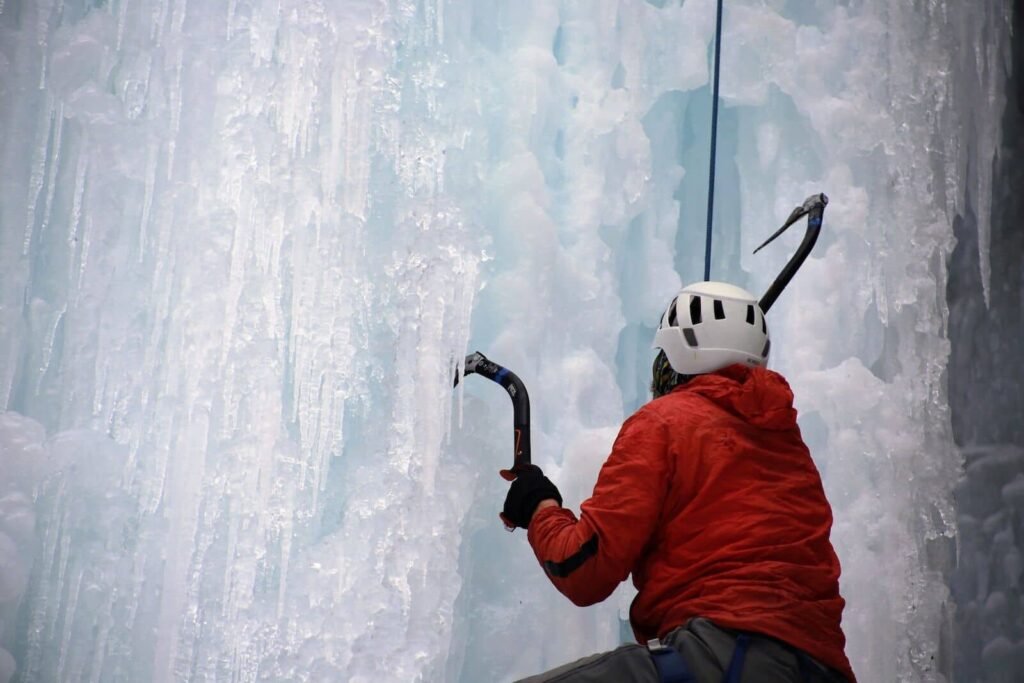A Comprehensive Guide to the Thrilling World of Ice Climbing
For many winter adventurers, exploring snow-covered canyons and frozen waterfalls is an exhilarating experience. However, some adventurers seek an even greater thrill – scaling those frozen waterfalls with spiked shoes and ice axes. Ice climbing, a thrilling sport that involves climbing icy faces, provides a unique and breathtaking adventure. While you don’t need prior rock climbing experience to try ice climbing, it’s essential to be familiar with some basic aspects of the sport before strapping on your crampons. First-timers should consider going with a guide and instructor, as ice climbing entails certain risks, especially in remote and cold locations.
Ice climbing offers a fantastic opportunity to challenge yourself physically and mentally, all while surrounded by the beauty of nature. As James Walter, an experienced alpine guide at Yamnuska Mountain Adventures, points out, you don’t need extensive experience to try ice climbing. With a positive attitude and a willingness to learn, even beginners can venture into the world of ice climbing.
Understanding Ice Climbing
As the name suggests, ice climbing involves ascending ice faces, much like rock climbing. Climbers typically tackle frozen waterfalls, ensuring the ice is thick and stable enough for climbing. The climbing process often involves one person ascending while another belays from below. Experienced climbers may also opt for lead climbing, where they drill holes to place temporary bolts in the ice as they progress. For first-timers, it is best to let a guide set up the top rope for added safety.
Comparing Ice Climbing to Rock Climbing
The difficulty of ice climbing compared to rock climbing depends on your strengths and weaknesses in rock climbing. Skilled rock climbers who effectively use their leg muscles to ascend will find that ice climbing is somewhat easier, as the ice climbing crampons on their boots offer excellent grip. Searching for footholds becomes less of a challenge compared to rock climbing.
However, those who primarily rely on their leg muscles for rock climbing may find ice climbing more taxing on their arms. Ice climbing axes weigh around 1.5 pounds and require continuous swinging and digging into the ice during the climb. This may lead to arm fatigue for beginner climbers who are not accustomed to such movements.
Do You Need Prior Climbing Experience?
Surprisingly, no prior climbing experience is necessary to attempt ice climbing. Guides at reputable organizations, like Yamnuska Mountain Adventures, are skilled at introducing first-timers to the sport safely. While physical ability is not the primary concern, guides are especially trained to address the mental aspect of the sport, including overcoming fear and hesitation associated with climbing on ice.
Assessing Climbs and Ice
Determining the safety of ice for climbing is a crucial skill, and guides play a vital role in ensuring climbers select appropriate sections of ice. Generally, bluer ice indicates some plasticity, making it safer for climbing as it offers better grip. Assessing factors like ice thickness and its connection to the wall is essential, especially when climbing on pillars. Ice climbing is graded on a scale from one to seven, with higher grades representing more challenging climbs.
Safety Considerations
Ice climbing, when guided by certified professionals, is a low-risk activity in terms of accidents. Guides provide safety techniques to minimize risks, and climbers are encouraged to wear helmets to protect against minor icefalls. However, rare but potentially serious risks include avalanches and ice falls. Selecting the right ice climbing location, conditions, and temperature is vital to mitigate such risks.
Appropriate Gear
Beginner ice climbers will need specific gear for a safe and enjoyable climb. Essential equipment includes ice climbing axes with curved grips, mountaineering boots, crampons, and a helmet. Guides often carry advanced technical gear, such as an ice drill, belaying devices, anchors, and bolts. It’s essential to clarify what gear is provided by the guiding company or ensure you have all the necessary equipment if you’re not with a guided tour.
Dressing for Success
Layering is essential when ice climbing due to the fluctuating temperatures during the activity. A moisture-wicking base layer helps regulate sweat, while a large puffy jacket provides warmth during breaks. Waterproof outerwear, a beanie, gloves, sunglasses, and other cold-weather accessories are necessary for a comfortable experience.
Finding Ice Climbing Opportunities
Ice climbing requires consistently cold weather to ensure stable ice conditions. Locations away from coastal areas, typically in mountainous regions, offer the best ice climbing opportunities. Popular ice climbing destinations include Ouray, Colorado, frozen waterfalls in Wyoming and Montana, and the Canadian Rockies around Banff National Park and Canmore.
Connecting with the Ice Climbing Community
To find climbing buddies or guides, explore Facebook groups and alpine clubs, where members often organize outdoor sports activities. Guiding outfits in different areas can also provide training and guidance for first-time ice climbers.

Ice climbing offers a thrilling and unforgettable adventure for winter enthusiasts seeking a unique challenge. With guidance from experienced instructors and proper equipment, even beginners can venture into the world of ice climbing. Embrace the breathtaking beauty of frozen waterfalls and canyons, and conquer the ice walls with spiked shoes and ice axes. So, don’t be intimidated – take that first step and prepare yourself for an exhilarating ice climbing journey.

